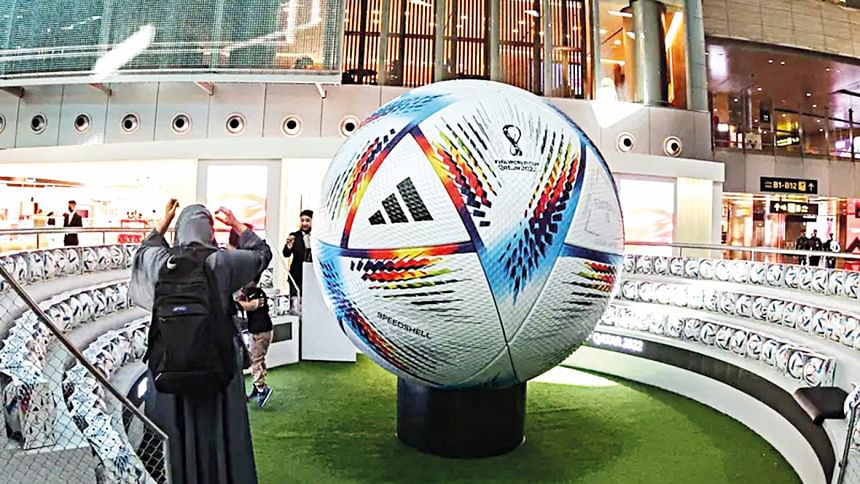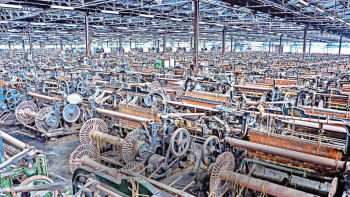Real lives in ‘artificial’ land

If you happen to come to Qatar from the subcontinent, you could often get confused whether you landed in an Arab land some 3000-4000 kilometres away from home or you were just in another of Bangladesh or India or Pakistan.
Of course, the streets and the modern buildings and the disciplined traffic will not give you such an illusion. Instead, it is the familiar faces that you would come across on the streets, on the shops, the roadside restaurants and signboards that will make you feel at home away from home.
The Qatari capital Doha and its surrounding areas are full of those familiar faces. They are everywhere: at the eight World Cup venues working as security guards or chefs, on the metros to guide you around the city, on the taxis, taking you to your desired destination, and of course on the construction sites, working off their sweat to raise modern cities from beneath the desert sand.

There are Filipinos too, and a lot of Africans, but you'll see very few Arabs in these places or walking down the streets.
This is Doha, Qatar – an adopted home for South Asians, who make up the second largest ethnic group among a population of nearly three million, a tenth of whom are residents, the rest migrant workers. This is Qatar – the uber-rich Arab state roughly the size of Sylhet division but flush with gas and oil, allowing it to extend its economic and political footprint far and wide.
And the FIFA World Cup is the boldest statement till date of its financial ability and political clout. The World Cup in Qatar has been two decades in the making – long before the oil-rich nation became the first Arab country to be awarded the rights to host the Greatest Show on Earth in 2010. There have been sporting and financial projects aimed at garnering support for Qatar's lofty ambitions, and celebrities made faces of those projects.
The awarding of the World Cup has brought about a new wave of infrastructure development activities here: the gas-rich nation has spent an estimated 300 billion dollars for the quadrennial tournament. It has built a brand-new metro system, seven new stadiums, a modern shipping port, an expansion of its main airport and raised an entire city out of scratch.
All that construction work and related services have brought droves of cheap labourers from the South Asian and African countries.

Rajab Ali is one such migrant worker from Bangladesh, working in Doha for the last six years after living in Saudi Arabia for 16 more. Rajab, from Daudkandi in Cumilla, isn't exactly involved in the construction sector, but it helps that there is a demand for his work all the time.
A welder by occupation uses his expertise in the trade and his connections to make a decent living.
He was having a cup of tea on the curb of an alley near the Fereej Abdul Aziz Street, close to Doha Downtown, when he caught the attention of this reporter.
Unlike many other labourers from the Bangladeshi background, he was more open in sharing his story and speaking about the condition of the Bangladeshis, despite noticing the accreditation card of a journalist.
He says he's had a rough time in the beginning after coming here following an altercation with his employer in Saudi Arabia. He's lost a fortune here after setting up his own company, before he turned his attention to working as a welder and making a pretty good amount since then.
There are others, though, who are not as street-smart as Rajab, yet happy with whatever amount they can save here.
The area where Rajab lives and its surrounding areas, including Doha Al Jadeda and Najma, are full of people of South Asian origin. Walking down the streets, you'll see many Bangladeshi owned restaurants, meat shops, barbershops, grocery shops, and money exchanges all across these areas.

Samir Chandra Sarkar from Mirershorai in Chattogram has been driving a company car for years now. He says everything is expensive here compared to Bangladesh. Then again, the payment is much better, which makes it possible for them to save some and send it home.
The World Cup season also helps small businesses thrive. But Samir says there have been some forced evacuations from these residential areas ahead of the World Cup in order to make accommodation for foreign visitors, even though the World Cup hasn't drawn as many visitors as Qatar had anticipated.
An hour's drive from these small pockets of desi hubs, in a place called Sanaya, you will get to see many more from the subcontinent and Africa. There are labour camps there – long stretches of tents and apartments where they live and work, far away from the reach of the metro that connects much of the city. It is a city in itself, with its own restaurants, parks, theatres and shopping malls and even a cricket stadium. The migrant workers have made those camps their homes for the time being.
Jahirul, a restaurant employee in Doha Al Jadeda, says he's been living here for the past three years after coming on a free visa. He is saving up enough money so that he can go back home one day and raise a family.
"Everything here is much better compared to what we have back home," he says. "There is no issue of security, no pollution, no traffic jam. But you know what, it all feels very artificial. I feel as if there's no life."
Indeed, Qatar has built a spectacle around the World Cup. It has wide streets and tall buildings, planned commercial and residential areas, shopping malls and hi-tech infrastructure to make life comfortable for the locals and the tourists. It has all but completed the World Cup without any major glitch.
And yet, there is a lingering feeling of artificiality surrounding everything. The vibrancy of life and the festivity of such a human congregation is somewhat missing.

 For all latest news, follow The Daily Star's Google News channel.
For all latest news, follow The Daily Star's Google News channel. 



Comments